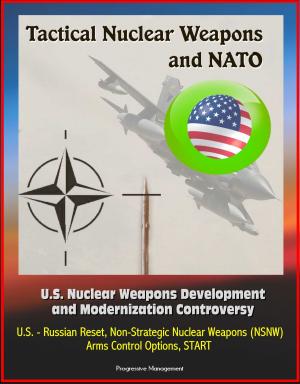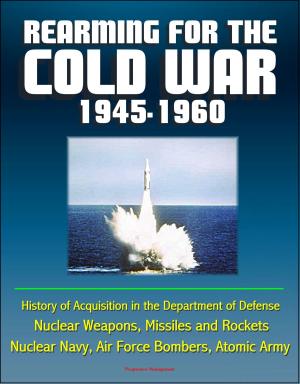Punishment, Revenge, and Retribution: A Historical Analysis of Punitive Operations - Justifications for War, British Army Somaliland, U.S. Punitive Expedition 1916, El Dorado Canyon Libya 1986
Nonfiction, History, Military, Strategy, United States| Author: | Progressive Management | ISBN: | 9781311725325 |
| Publisher: | Progressive Management | Publication: | June 30, 2016 |
| Imprint: | Smashwords Edition | Language: | English |
| Author: | Progressive Management |
| ISBN: | 9781311725325 |
| Publisher: | Progressive Management |
| Publication: | June 30, 2016 |
| Imprint: | Smashwords Edition |
| Language: | English |
This excellent report has been professionally converted for accurate flowing-text e-book format reproduction. Using military force against an enemy to punish, avenge a wrong, as retribution is a timeless cause of armed conflict. There are many examples throughout history of successful punitive operations. Analyzing historical punitive expeditions for the elements that made them successful or unsuccessful can aid future military and government leaders in framing strategic and operational conflicts, and serve as a backplane for attempting to understand the nature of punitive expeditions and strikes.
The purpose of this monograph is to study punitive attack and assess what makes these operations successful or unsuccessful. To do this, we first analyze what punitive operations are, and their place in the causes and reasoning for war. By surveying early international law we can see that attacking to avenge a loss or as retribution is an enduring and justified cause of war. Revenge is a uniquely human emotion, and one that is present even in primitive societies who did not wage war against another tribes.
In the United States, one of the earliest scholars who wrote about the laws of war and how they affect punitive doctrine was Francis Lieber. Lieber's Code gives us the idea of military necessity, an important element of punitive operations or actions. Some of the modern concepts of punitive war are found in the early writings on small wars in both the British Army and the United States Army and Marine Corps. In manuals, professional journals, and school instruction one can find the vestiges of a doctrine for punitive operations and expeditions.
The historical campaigns of both the British and the United States provide some excellent examples of punitive operations in execution. The twenty year fight by the British army against the Mad Mullah in Somaliland ended with the use of the airplane to finally quell the Mullah's influence. The United States Army under the command of General John Pershing launched a punitive expedition into northern Mexico in search of the bandit Poncho Villa. A large United States Force pursued Villa, responsible for a cross -border raid into New Mexico, for nearly a year. Pershing never captured Villa, but fought and killed a number of his bandits. A modern example of a punitive strike was The United States 1986 air raid on the country of Libya. This series of air strikes by the United States Navy and Air Force were in response to Libya's support of international terrorist activities against the United States and its western allies.
Drawing on a combination of human behavior, just war concepts, and historical examples allow one to define some elements that may be a useful framework for punitive strikes. Human emotion, revenge, and vengeance are all uniquely human characteristics and will have an enduring impact on conflicts of the future. Reponses against nations or actors that are punitive must be timely and warranted. The length of time it takes to respond can and will contribute to effectiveness. Any action that seeks retribution or deterrence must have a limited and attainable objective. Overwhelming force or some asymmetrical advantage is key here as well, as a failed punitive strike becomes something else altogether. Measures of effectiveness for a punitive operation are difficult to determine, and can be a function of one's own behavior as much as an adversary's. One important facet of punitive operations is in their residual deterrence value. Deterrence is the perception of the potential for the use of force. Potential force may be effective against sophisticated and organized polities; however, for primitive loosely organized enemies, the actual use of physical force may be the sole method for achieving a level of deterrence.
This excellent report has been professionally converted for accurate flowing-text e-book format reproduction. Using military force against an enemy to punish, avenge a wrong, as retribution is a timeless cause of armed conflict. There are many examples throughout history of successful punitive operations. Analyzing historical punitive expeditions for the elements that made them successful or unsuccessful can aid future military and government leaders in framing strategic and operational conflicts, and serve as a backplane for attempting to understand the nature of punitive expeditions and strikes.
The purpose of this monograph is to study punitive attack and assess what makes these operations successful or unsuccessful. To do this, we first analyze what punitive operations are, and their place in the causes and reasoning for war. By surveying early international law we can see that attacking to avenge a loss or as retribution is an enduring and justified cause of war. Revenge is a uniquely human emotion, and one that is present even in primitive societies who did not wage war against another tribes.
In the United States, one of the earliest scholars who wrote about the laws of war and how they affect punitive doctrine was Francis Lieber. Lieber's Code gives us the idea of military necessity, an important element of punitive operations or actions. Some of the modern concepts of punitive war are found in the early writings on small wars in both the British Army and the United States Army and Marine Corps. In manuals, professional journals, and school instruction one can find the vestiges of a doctrine for punitive operations and expeditions.
The historical campaigns of both the British and the United States provide some excellent examples of punitive operations in execution. The twenty year fight by the British army against the Mad Mullah in Somaliland ended with the use of the airplane to finally quell the Mullah's influence. The United States Army under the command of General John Pershing launched a punitive expedition into northern Mexico in search of the bandit Poncho Villa. A large United States Force pursued Villa, responsible for a cross -border raid into New Mexico, for nearly a year. Pershing never captured Villa, but fought and killed a number of his bandits. A modern example of a punitive strike was The United States 1986 air raid on the country of Libya. This series of air strikes by the United States Navy and Air Force were in response to Libya's support of international terrorist activities against the United States and its western allies.
Drawing on a combination of human behavior, just war concepts, and historical examples allow one to define some elements that may be a useful framework for punitive strikes. Human emotion, revenge, and vengeance are all uniquely human characteristics and will have an enduring impact on conflicts of the future. Reponses against nations or actors that are punitive must be timely and warranted. The length of time it takes to respond can and will contribute to effectiveness. Any action that seeks retribution or deterrence must have a limited and attainable objective. Overwhelming force or some asymmetrical advantage is key here as well, as a failed punitive strike becomes something else altogether. Measures of effectiveness for a punitive operation are difficult to determine, and can be a function of one's own behavior as much as an adversary's. One important facet of punitive operations is in their residual deterrence value. Deterrence is the perception of the potential for the use of force. Potential force may be effective against sophisticated and organized polities; however, for primitive loosely organized enemies, the actual use of physical force may be the sole method for achieving a level of deterrence.















